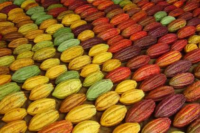Premium Proliferation
By Mary Ellen Kuhn
Chocolate is getting more complex, but one part of the picture is pretty simple: Consumers can't seem to get enough of the higher-end stuff.
If
there’s a confectionery category that is exciting to watch right now,
it’s premium chocolate. Sales are red-hot, and thanks to
consumers’ increasing sophistication and evolving palates, the
category itself is undergoing a rapid evolution. There’s a product
for every preference — whether it be single-origin, organic,
high-cacao-content, dark or milk chocolate — which is great for
consumers but can get complicated for retailers struggling to find space on
their shelves for the rapidly expanding array of premium products.
“There are far more SKUs than you could possibly
carry,” says Mike Overschmidt, candy category manager for the
Milwaukee-based chain of 155 Roundy’s Supermarkets. “You have to follow the 80/20 rule,” he
observes. That means recognizing that the top-selling 20 percent of
products will account for 80 percent of sales.
“The other 20 percent is what you stand
for,” Overschmidt adds. In other words, it’s by cultivating a
distinctive, diverse assortment that the retailer creates a meaningful
shopping experience for store patrons, recognizing all the while that most
— i.e. 80 percent — of these items won’t be top sellers.
The ‘evolved’ chocolate lover
Presented with an increasingly wide array of product
options, it’s no surprise that consumers’ appreciation of high
quality chocolate is evolving. “It’s much like consumers have
come to understand olive oil, red wine and coffee,” says Jean
Thompson, CEO of premium chocolate maker Seattle Chocolates, based in the
city of the same name. “The more educated they become and the more
they try things, the more they are going to go for better
chocolate.”
“A lot of this is coming from Europe,” says
Edward Seibolt, vice president of sales for Fannie May Confections Brands
Inc., North Canton, Ohio. “Taste buds may be changing, may be
maturing, and Americans seem to like the taste of bolder, more flavorful
products, especially with dark chocolate.”
“Once a consumer’s palate has become
accustomed to a product like high-end chocolate, they just don’t go
back,” observes Denise Shoukas, communications director for the
National Association for the Specialty Food Trade, New York, N.Y
One of the things consumers have come to understand
about chocolate is that, thanks to its antioxidant content, it need not be
viewed as a nutritional negative. Instead (at least when it is consumed in
moderation), chocolate has moved into the good-for-you column.
Permission granted
“In the last five years, with the information
about health benefits that has come out, it has given consumers permission
to enjoy something that they’ve always enjoyed,” Thompson
reflects. And that, she notes, “opens the door to more everyday
consumption.”
“Everybody [now] knows that chocolate in small
quantifies is good for you,” observes Jane Barrett, vice president of
marketing for Sausalito, Calif.-based artisan chocolate maker Coco-luxe
Confections, which began operation last year.
“What we are noticing is the rise of what I would
call healthy chocolate,” says Barrett. “We’ve seen a
shift in the market … to a higher-end product with a higher cacao
content and less sugar.”
Coco-luxe is tapping into the health angle by
introducing products formulated with ingredients such as green tea, goji
berries and pumpkin seeds. “We’re trying to walk the line of
interesting and not unhealthy,” says Barrett.
Watch for more upscale chocolate formulated with
“superfruits” like the aforementioned goji berries and also acai berries, NASFT’s Shoukas predicts.
Harry London’s Assorted Gourmet collection
unveiled late last year makes ample use of fruit ingredients, including
raspberry, pear and apple. “The real fruit inclusions have become
very popular; consumers are moving in that direction,” says Edward
Seibolt, vice president of sales for Fannie May Confections Brands, North
Canton, Ohio, of which Harry London is a subsidiary.
Perhaps nowhere is the health and wellness angle more
clearly communicated than with The Hershey Company’s unambiguously
named Goodness Chocolate portfolio. The line-up includes dark chocolate and
chocolate with fruit and nut inclusions as well as two milk chocolate
offerings — Hershey’s Whole Bean Chocolate, which is low in
sugar and high in fiber and antioxidants, and Hershey’s Antioxidant
Milk Chocolate. These offerings might even be said to create a new niche
because, until now, dark chocolate has been the beneficiary of almost all
of the positive press about antioxidants in chocolate.
What’s your number?
For a growing number of “well-educated”
chocolate lovers, percentage cacao content is a key indicator of product
quality, with introductions labeled 60 percent, 70 percent and even upwards
of 80 percent increasing in frequency.
For a relatively select group of dark chocolate
aficionados, the trend may be “the higher the better.” Earlier
this year, for example, San Francisco-based Guittard Chocolate Company
unveiled the E. Guittard Nocturne 91% Cacao Extra Dark, made from what the
company describes as a “uniquely complex blend of about seven
different beans from each of the three major cacao-growing
regions.”
Thompson isn’t ready to embrace cacao-content
labeling for Seattle Chocolates’ products, however. “We
don’t want to hang our hat on the cacao content,” she says,
noting that products with very high levels of cacao may be too bitter for
some palates. Thompson acknowledges that her position may change in the
months or years ahead. “As consumers become more educated, we might
have to do it,” she notes.
Back to the beginning
Another high profile trend in premium chocolate has
been the emphasis on the origin of the cocoa beans. “There is a
definite shift and growth in chocolate being more like wine,” says
Shoukas. “With single-origin products, you can know the exact region
of the world where the bean came from.”
Hershey added four chocolate bars made with cocoa beans
from specific countries to its Cacao Reserve line late last year.
Masterfoods’ premium Dove Chocolate introduced Dove Origins with bars
and squares that deliver the flavors of Ecuador, Ghana and the Dominican
Republic.
Zurich-based cocoa supplier/chocolate maker Barry
Callebaut also is addressing interest in single-origin chocolate with the
rollout of four new single-origin chocolates this spring. Beyond that, the
company’s Cacao Barry line now includes an exclusive,
plantation-specific chocolate available in limited quantities for pastry
chefs and chocolatiers. Eric Martinet, vice president of gourmet products
for Barry Callebaut North America, describes it as “one-of-a-kind,
high-end vintage chocolate.”
Mainstream appeal
There’s plenty of creativity in evidence with
upscale chocolate formulations. Artisanal chocolate makers are pushing the
envelope with concoctions that include “exotic” ingredients
ranging from chai tea to sea salt. The more mainstream premium chocolate
makers, not surprisingly, are sticking closer to classic favorites.
“At Ghirardelli, we are focusing on introducing
the best, not the most exotic, dark chocolate recipes to the market,”
says Danielle Jin, director of marketing for Intense Dark, Baking and Hot
Chocolate. Prior to the launch of Ghirardelli’s popular line of
Intense Dark bars, “we went through a very rigorous consumer research
process to identify the most appealing dark chocolate concepts,” she
says. The testing led to a line-up that includes Twilight Delight (with
mocha, blackberry and dark cherry notes), Espresso Escape, Toffee Interlude
and Citrus Sunset bars.
At Seattle Chocolate, the goal is flavor combinations
that are “interesting, but not bizarre,” says Thompson, citing
favorite ingredients such as toffee, almonds and peanut butter. “We
see the largest number of people just wanting the product to taste
good,” she says.
Expanding the experience
It’s important to educate consumers about how to
enjoy premium chocolate, says Ghirardelli’s Jin. To that end,
Ghirardelli recently launched the Website www.savorchocolate.com , which
provides consumers with fun chocolate facts, ways to taste chocolate,
chocolate party ideas and chocolate recipes.
Heightened interest in premium chocolate bars can mean
new marketplace opportunities for savvy companies. Seattle
Chocolates’ Thompson says sales of the company’s chocolate
dessert shells shot up 700 percent in the past year, prompting Seattle to
extend the line with the introduction of a white chocolate dessert shell.
While industry watchers expect premium product
proliferation to continue in the short-term, they agree that the brands
that ultimately survive in the marketplace will be those that do the best
job of delivering both value and quality.
“There are brands out there that are nothing more
than pedestrian chocolate,” observes Roundy’s Overschmidt.
“They will be seen for what they are,” he predicts. “Like
everything else, it is a value proposition: Is it quality? Is it price? And
the value proposition can include strong marketing or some sort of other
affinity from the customer.”
“I think there’s probably room for a
variety of players,” says Thompson. “I think in time, the cream
will rise to the top — that is the brands that consistently deliver
the best quality product for the best price.”
Don't Box Them In
With its new Assorted Gourmet collection, Harry London
Chocolates tackles one of the boxed chocolates category's challenges head
on. That challenge is generating everyday interest in an upscale category
linked primarily to seasonal sales.
"The opportunity we have is that although it
works for the holidays, it really is an everyday line," says Edward
Seibolt, vice president of sales for Fannie May Confections Brands, North
Canton, Ohio, of which Harry London is a subsidiary.
To that end, the product offerings — which
includes truffles, cream caramels, soft nougats, velvet creams, toffees and
more — are displayed in elegant, earth-tone packaging. And with price
points that range from $9.99 to $24.99, "we think we're a good value
compared to some of our competitors," says Seibolt.
Accessible price points are critical for everyday,
even with "luxury" type products, Seibolt explains, because
consumers tend to be less flexible in their "everyday" spending
behavior. On the plus side, however, is the fact that more mainstream
retailers are creating space for specialty boxed chocolates.
And Harry London has been quick to adapt its boxed
offerings to meet the needs of the various channels. "With club, what
we're doing is taking our gourmet confections and putting them in a
packaging system that works well for the channel — packaging that
looks and displays well on pallets," Seibolt notes.
Seattle Chocolates CEO Jean Thompson concedes that the
everyday market is tougher than seasonal because at the seasons, it's
easier for a retailer to allocate an endcap or some space in the seasonal
aisle.
“Most of our success has come from retailers
taking in our Christmas or Valentine’s SKUs,” she says.
“It’s easier to bring in, and not as big a change to the
planogram.”
That hasn’t stopped the company from introducing
a new, non-seasonal boxed line adorned with a fun, contemporary look of
pink, blue and brown polka dots and stripes. The company has applied a
similarly fresh approach to the box itself, which is cube-shaped vs. a more
traditional rectangular box.
“People are not currently buying boxes of
chocolate for themselves,” observes Jane Barrett, vice president of
marketing for Sausalito-based Coco-luxe Confections. "One of the
things that we have started to market and are doing very well with is our
box of three." The company has gained distribution for these petite
offerings in nontraditional locations including spas and coffee shops.



